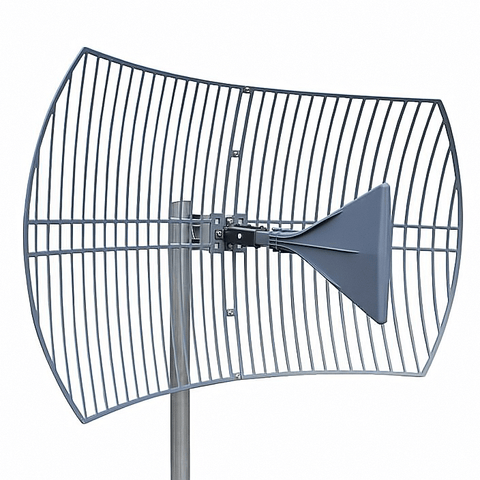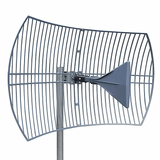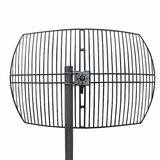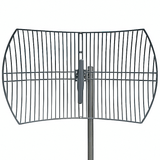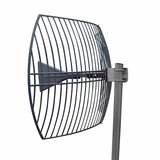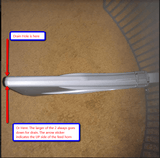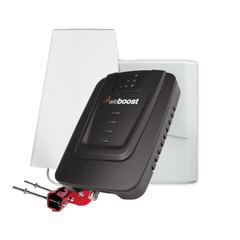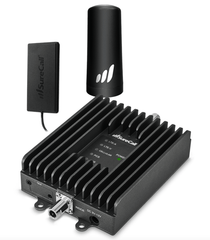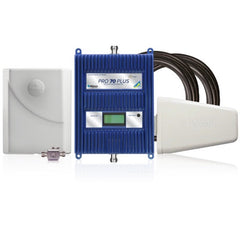RF Boost Long Range Antenna for Cellular & Wi-Fi (Grid Parabolic)
RF Boost Long Range Antenna for Cellular & Wi-Fi (Grid Parabolic)
Buy Now, Pay Later with No Interest if paid in full within 6-12 months. Choose Klarna payment option at the checkout for details of this, and other long-term low-interest financing options.
Free Lifetime Support. SKU / Model: G665UWBSB
- Ultra Directional Antenna (Focused Aiming Required).
- Impedance 50 Ohm with N-Female Connector.
- Longest Reach and Highest Gain Outdoor Mounting Antenna.
- Gain (dBi): 15 to 26, based on frequency band.
- Operating Frequencies: 600-6500 MHz (600 MHz to 6.5 GHz).
- Bands: All Cellular 2G/ 3G/ 4G/ LTE/ 5G, WiFi, Wi-Max, AWS, GPS.

Would you like to buy the cable that connects to this antenna's N-Female connector? Usually purchased with cable that has N-Male connectors to match up connecters with all 50 Ohm cellular amplifier systems (to replace its outside stock antenna), or bought with cable that has N-Male to SMA Male connectors for many cellular modems or signal amplifiers such as Cel-Fi Go. For many mobile hotspots such as NetGear NightHawk, PepWave, CradlePoint, MoFi, and others: To match up connecters directly with their cellular modem (to replace whip or right angle stock cellular antenna), you may also need TS9 connector in addition to cable that has N-Male to SMA Male connectors.
1(855)846-2654
Need installation quote, or help with designing a custom solution? Submit a request for quote.
- Description
- Reviews
- Questions & Answers
- Make An Offer
- Warning
Description
Product Description
Made in USA, RF Boost long range cellular and wi-fi grid parabolic antenna / aerial is an ultra wide band cell phone and wifi antenna that ensures you get a quality wifi and cellphone signal to enjoy top high speed connection for your wifi or mobile coverage needs. It has 50 Ohm impedance with N-Female connector and connects to any cable with N-Male connector. If you have 75 Ohm cable with F-Male connector, buy 75 Ohm ultra directional antenna with F-Female connector.
Wide Band 600-6500 MHz (600 MHz to 6.5 GHz) 3G, 4G, LTE, 5G Directional Antenna (50 Ohm). Up to 26 dBi Gain Longest Reach and Highest Gain Outdoor Mounting Antenna for all Cell and Wi-Fi networks.
This large diameter parabolic cell booster antenna is engineered using the latest patented technology capable of providing the best possible signal improvement functionalities. As an uninterrupted gain cellular antenna, it is the best of its kind in the market today.
Being an ultra directional antenna, RF boost antenna makes sure that high gain is achieved when pointed precisely towards the source of signal. Other than that, you don't really need to calibrate or adjust anything. External cell antenna tuning is not required. It simply provides the best possible gain that meets your needs.
Essentially, Ultra Wide Band Long Range Cellular Antenna works with diverse frequency bands, purposes, and industries including:
- Radio telescope.
- 2G/ 3G/ 4G/ 5G, CDMA, UMTS, ISM, GSM, LTE.
- Wi-Max.
- GPS.
- Aerospace exploration.
- Military.
- Homeland security.
- Cellular.
Ultra wideband long range antenna is also a weatherproof choice - perfect for the outdoors. It is made using the most reliable and durable materials that can withstand diverse elements outside.
Top continuous gain cellular coverage booster antenna.
This ultrawide band long range wifi and cell antenna remains the top choice for replacement in wifi booster kits and cell phone booster kits for best continuous coverage. It is designed using a unique patent that makes it possible for top directionality and high gain on virtually all available bands ranging from 600 MHz to 6500 MHz frequencies. Future-proofed with 5G Band 71 compatibility that includes 5G T-Mobile Band 71 Sub-6 Frequency.
Its radiation and continuous gain properties at times indicated as instantaneous gain ensure that the cellular signal booster antenna has the capability to effectively radiate at the right frequency range it was engineered for.
The long range antenna makes easy work of installation for everyone; it begins to operate right after unpacking for all devices falling anywhere within the 600MHz and 6500MHz spectrum. It also comes with a feature allowing for greater optimization of the upper and lower parts of the ultra-wide bandwidth. If you intend to use it immediately you don't really require any calibration or adjustment.
Technical Specifications of G665-UWBSB:
- 600MHz-6500MHz Frequency Range (UWB - Ultra Wide Band).
- Vertical or Horizontal Gain Polarization.
- Gain: 15 dBi Low Freq./ 20 Mid Freq./ 25 High Freq.
- Half-power Beam Width (°) Low Bands: 20 Horiz., 23 Vert.
- Half-power Beam Width (°) Mid. Bands: 12 Horiz., 15 Vert.
- Half-power Beam Width (°) High Bands: 7 Horiz, 9 Vert.
- HFront-to-back Ratio: 20dB AVG.
- Impedance: 50 Ohm.
- VSWR: 1.6:1 / 1.4:1 AVG Max.
- 100W Input Power Max.
- DC Ground Lighting Protection.
- N-Female Connector.
- 24x39x16/ 60x99x40 (in/ mm) - dimensions when installed.
- 20x25x4/ 51x63x10 (in/ mm) - dimensions when boxed.
- 5.3 lb. / 2.4 kg. - weight with bracket.
- 7.2 lb. / 3.3 kg. - total weight with packaging.
- Rated Wind Velocity 130 / 209 (MPH / KPH).
- Wind Load @ Rated Velocity 150 / 68 (M / K).
- 1.5-2.0 / 40-50 (in/mm) Mounting Mast Diam.
- Aluminum Reflector Material.
- Electrostatic Powder Coat Finish Reflector.
- ASA Anti UV Antenna System Radome Material.
- Flat Gray Antenna Color.
- IPX Weather Rated Water Resistance.
- -40 to +60 / -40 to +140(°C / °F) Operating Temperature.
- Made in USA with imported materials / parts.
Covered frequencies and bands.
Ultra wide-band antenna works with all carriers and frequencies in United States and Canada as well as virtually anywhere around the world. It works perfectly for boosting internet connection once you attach it to a working cellular or wifi modem. The long range cell phone signal antenna also works perfectly with all cellular signal boosters out there from HiBoost, SureCall, Cel-Fi, weBoost, and Wilson Electronics, among others.
All that is needed in the box.
Long range antenna comes in a packaging containing all that you need to put into work right away. Installation and assembling is super easy. You need to connect it to a cellular hotspot or cellular repeater/booster. Even so, a cell signal strength meter and cable are great to have.
Need help with installation of this antenna?
If, after receipt, you realize that you need help with installation, a professional installation of this antenna is available for your residential address or business commercial address anywhere within USA 50 states. Please contact SignalBooster.com with your order number after purchase and receipt of this antenna for your home, or office / retail store building for instructions to pay and schedule installation at the flat fee cost of $149.99 by a certified professional installer.
Also works with Mofi 4500.
If you have a Mofi 4500, this ultra wide range mobile antenna comes in handy right away. It is a unique antenna and provides the best possible gain and perfect if you have been disappointed before by other types of similar antennas. It can easily pick up diverse carrier bands in United States, such as Band 12, 4 and 2 for T-Mobile users. Make the most of the Mofi to effectively make use of any of the supported bands as per the available signal strength appearing on the status page of the Mofi.
Cables and connection.
Essentially, it works with all cell phone signal boosters as far they are N-Female connectors. This means that all you require is a cable with N-Male as one of the connectors. For other cables you might have to pick the best according to exactly what you will be plugging into. For instance, devices such as Mofi have SMA-Female connectors inbuilt and the cable you end up using must be a perfect SMA-Male to fit.
Those intending to plug into devices such as Nighthawk M1 among other gadgets, all that is required are TS-9 connectors. It means an N-Male and SMA-Male configuration cable is okay. However, you might require a pigtail or adaptor SMA-Female to TS-9. This is important since TS-9 isn't a large connector and doesn't usually match with larger types of coaxial cables used to connect with the outdoor antenna.
Here's a link of pigtail cable N-Female to TS9 Male connector and a link of N-Female to SMA-Male connector. N-Female connector connects to any type 400 cable such as SC400, Wilson400, LMR400, etc. and other end connector TS9 male, or SMA male connector connects to whichever connector-type cellular device you have.
For those who might have Quad Core RG6 cables for antenna up to 50 feet, it is worth noting that this is 50 Ohm antenna while the RG6 cables are generally for 75 Ohm antennas. You could go for adapters that would make it possible to effectively use the antenna but the best results will depend on the particular device you intend to connect the antenna with, and how you end up configuring the system.
Antenna Key Characteristics.
It is perfect for boosting Wi-Fi and cellular signals, from 2G, 3G to 4G LTE and 5G. It doesn't matter what model of cell phone you're using; the long range antenna will work with it perfectly well, including all carriers globally, such as AT&T, Verizon and T-Mobile for US users. The long antenna also supports all cell signal booster makes and brands, including HiBoost, Wilson Pro, Cel-Fi among others.
Highest possible gain is assured and much better than the most cellular signal antennas out there. It offers up to 26dB gain which is six times stronger than the typical Yagi antenna out there. With an adjustable feedhorn, it makes sure the gain can be boosted from any part of the spectrum as per your needs.
It is designed to last the longest possible time courtesy of an aluminum patented grid mesh capable of surviving the harshest possible elements such as unforgiving hurricane winds. Water that gets in the horn mostly dries up or drains out of the microscopic drain hole that is at the tip. Any residual water freezing inside of horn should not be of concern because material is strong enough to withstand expansion of small amount of water when it freezes.
Why is ultra wide band long range cellular antenna a superior product?
Exceptionally long range for widest frequency range (600-6500 MHz).
For those living in some of the hardest terrains where the cellular signal is spotty, the cellular outdoor Ultra Gain 26dB antenna ensures that you can find cell towers that could even be 10 miles from your office or home. In contrast, most Yagi antennas have a 2-5 mile range only. Secondly, it covers 2G, 3G, 4G, LTE, 5G frequencies between 600 MHz through 6500 MHz which is wider range than other antennas. It is so effective that dead zones will be easily turned around into areas with working cell signals while sections with poor to weak cellular coverage will have a reliable internet and voice quality.
Signal-Noise performance unequalled.
Ultra Wide Band Long Range Ultra-Gain 26 dB antenna comes in handy when it comes to enhancing the performance of any cell phone signal booster out there. In a situation where cellular towers are in competition and as a result cause so much noise, the antenna's directional attributes allow the device to connect directly with the proper cell tower you wish to access.
Directional field very narrow for best reception.
One of the reasons why this long range antenna is perfect for installers is its high gain uniqueness. When it comes to boosting virtually all the available carriers and one carrier or a number of them try to surpass the others, the antenna is designed to bypass any overwhelming tower and directly engage that particular carrier you intended to connect with but couldn’t. However, it must be pointed precisely to relevant tower using signal meter or spectrum analyzer. A smartphone in field test mode would do as well.
Quality make, low cost.
The long-range superior build quality of the ultra wide high gain parabolic grid antenna is designed in such a way that it protects the device against such debilitating elements as moderate-to-heavy tempests known to knock out antennas and damage their placement. It is similar or much better than other models in the market that mostly cost a lot more: BT974822 | BT512495 | BT974921 | G02 | GO2 | ANT66NF-GP | B07PQ978P9 | B07ZTRBTZ4 | B08FBN5LJ7 | B07NJNC3MV | B08R6Q13G5.
Adjustable feed-horn for maximizing Gain on specific frequencies.
This almost future-proof antenna covers continuous frequencies from 600 MHz to 6500 MHz or 6.5 GHz that includes cell and wifi bands. It offers huge optimal Gain up to 28 dBi. It can be customized for tuning further to specific frequencies you need for highest Gain on those frequencies. Adjustable knobs below antenna horn enable you to push the feed horn in, or pull it out depending on which band you want to optimize. For example, if you want higher Gain on bigger frequencies like lower LTE band, you would pull the feed-horn "out" and away from the metallic grid so it can reflect more on the metal grid dish. If you push the feedhorn "in" for smaller frequencies, it would optimize for most Gain on upper part of the spectrum meaning upper band frequencies. As default, the antenna horn setting is in the middle to provide average Gain throughout all frequencies.
Horn Placement.
Antenna feedhorn positioning on this antenna is adjustable. The brackets included enable you to adjust the feedhorn position mounting as needed. For using with a standard Single Input, Single Output (SISO) signal booster system like made by SureCall or WilsonPro, you would simply leave the feed horn horizontal to catch best signal. However, if you have a Multiple Input, Multiple Output (MIMO) device that you're boosting signal for, cross polarized antennas are better in line with the cell towers and thus can almost double the bandwidth.
Therefore, for better throughput when using two of these antennas for a single MIMO device signal boost, you can adjust the feed horn on both antennas in a cross fashion. One slated to the left, and one slanted to the right. For example, one antenna feed horn blade going from NE to SW and other antenna feed horn blade going NW to SE. Two antennas with their horns positioned in this manner are called cross polarized antennas for maximum signal optimization on MIMO devices such as Netgear Nighthawk hotspot.
Cellular signal booster and directional antennas.
If you need a solar power cell phone signal booster, this is the next best thing. A solar powered cellular amplifier or repeater would provide higher Gain but at up to +26 dB Gain, this passive antenna with no electrical hook-ups is a great alternative.
Are you using a cell phone signal booster and directional antennas but unsure about the direction of the cell tower? Use a cell phone signal meter, spectrum analyzer, or your smart phone in test mode. Thereafter, using this antenna shouldn’t be an issue. Simply replace old inefficient antenna with this one and see the difference. You may need to focus the horn to point to the relevant cell tower more precisely for the best results. This antenna is really wide band and transmits and receives all manner of cellular bands out there. The antenna is also high gain and shouldn’t be a problem at all. Please note that due to its focussed power, the strength of incoming signal can overwhelm some consumer cell signal boosters. If that happens, redirect the beam away slightly away from pointed cell tower to prevent overload.
Please note that since this is a parabolic antenna with narrower focus range (only 10 degrees) than other directional antennas, you have to directly aim it at a specific tower or direction and the resultant signal will be the best possible one. For best results, ensure you have mounted the antenna in such a way that it moves around horizontally on a vertical axis along 360 degrees so it can be adjusted precisely along a wide area. Once the antenna has been connected with the cellular signal booster and you are able to rotate it easily, go to your Smartphone and enter into Field Test Mode to examine the gain reading while carefully moving the antenna about.
As you continue testing various directions, one of them will have the best and highest possible signal. That way, you would have found the best possible tower and sweeping along the 360 degrees axis should point you towards the strongest possible one you need to aim at. After finding the best cell tower direction, adjust the antenna the best way possible to efficiently maximize on the gain as read from your cellular device and place the antenna firmly.
Radiation Pattern on 600-960 MHz / 0.6-0.96 GHz providing up to 12-17 dBi:
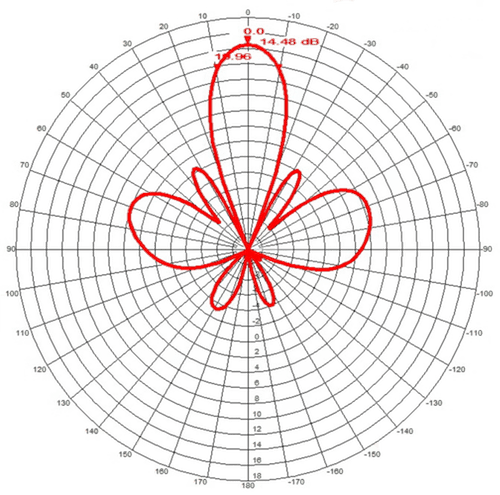
Radiation Pattern on 1700-2700 MHz / 1.7-2.7 GHz providing up to 20-23 dBi:

Radiation Pattern on 3000-6500 MHz / 3-6.5 GHz providing up to 23-26 dBi:
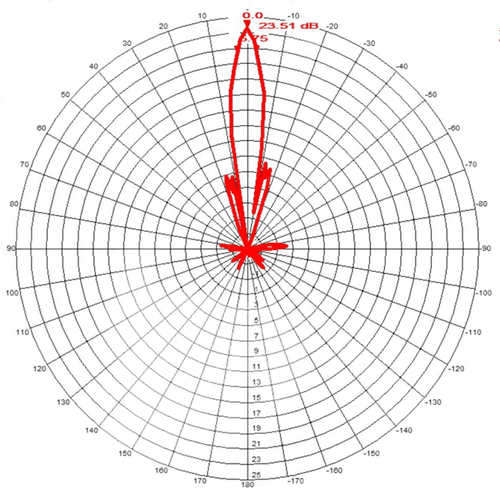
Reviews
Questions & Answers
QUESTIONS & ANSWERS
Ask a Question-
Will this work with a Sierra Wireless RV-50 router?
Yes, it is compatible with Sierra Wireless RV50 router.
-
Is band 66 and band 30 not supported by this antenna booster?
Yes, this antenna supports both band 30 and 66 frequency signals. However, please note cell signal boosters don't support band 30 and / or band 66. Therefore, this antenna must be used independently of a signal boosting system. It can be used by connecting it to your cellular modem using band 66 and 30 frequencies with a suitable coaxial cable and connector that fits it. Contact us if you need help seelcting the cable, and connector, or read description for links to suitable cable, plus connector you may need. Thank you.
-
Which 5g antenna you sell covers the n41 frequency band?
Yes, this reference antenna covers 2500 MHz frequencies (n41 band) to capture, and boost cellular reception in a passive manner (no power needed - just connect to your cell signal network router or modem). It absolutely supports Band 41.
-
How can this antenna help with better signal to my Verizon cell phone? How do I connect or sync it to my phone?
This high gain antenna by itself may not cut it without powered cellular amplifier, unless you inquire with your carrier Verizon Wireless whether you can get a cellular hotspot device or modem added to your monthly plan into which you can connect the cable from antenna to antenna port of that cellular modem or Mi-Fi.
OTA (Over The Air) signal caught from passive parabolic antennas like this needs to be fed directly to a powered device to see significant improvement in connectivity. Since your cell phone would not have antenna port as first generation phones used to have, either mobile hotspot producing device, or a cellular amplifier kit would be needed to accomplish the task.
Then your cell devices can tap into that boosted cell coverage of either mobile hotspot device service, or your cell service boosted by cellular signal amplifier for consistent connectivity to Verizon Wireless mobile network.
If adding a mobile hotspot to your cell phone plan is not practical and if signal is non-existent or extremely weak inside, we highly recommend this powerful signal booster kit with 50 Ohm exterior antenna port and low loss cables that us installers use for absolutely terrific cellular coverage boost in most home installations.
You can even buy this parabolic antenna in addition to switchout with kit-included directional Yagi or log periodic (LP) antenna for even higher boost because stock antenna offers up to 12dBi Gain versus this parabolic antenna offers up to 26dBi Gain. Please note that even compared to the Yagi directional antennas, this ultra directional parabolic antenna needs to be super precisely pointed to nearest cell tower preferably using a signal meter.
If buying the suggested cellular booster (or any other for that matter), the kit will include detailed instructions on how you can install the booster kit on your own, or you can buy similar kit with professional installation service included - wherever you live in USA. If you buy the kit with installation included, you're essentially paying $300 to have a professional installer install the similar booster kit for you. -
I have a mofi 4500 and I use two sma male to n male. Then use splitter all n-female to connect both sided n-male cable to a n-female antenna correct?
You have the connections correct but you need one antenna for each port.
-
I have the Nighthawk M1. How would I go about hooking this antenna up with MIMO?
You need a TS-9 adapter that will accept the connector of the cable you choose (usually SMA male).
-
Are the pole and stand included? If so, what are the dimensions?
Sorry, no mounting of any kind included except the clamp to any standard 2-3 inches pole mount.
-
Does this use 1 cable or two? SMA or TS9?
The connector on the back of this antenna is a type N-Female. Therefore, you will need to have a cable with at least one connection as an N-Male so that it can connect to the N-Female on this antenna. Other side of the cable is up to you to pick and is determined by what you need to plug it into. A MOFI device for example has an SMA-FEMALE connector built on it so the cable end to match is an SMA-MALE. If you are plugging into a Nighthawk M1 or similar device then it needs a TS-9 connector. Therefore you can probably still go with the same cable configuration as the MOFI (N-Male to SMA MALE) but then also buy an adapter or pigtail that is SMA FEMALE to TS-9. You will need to do this because TS-9 is a small connector that does not normally fit on the larger coaxial cables used to connect to the antenna outside. Summary: Cable required is N-MALE to SMA MALE for a MOFI and most cellular modems. In case your device requires a TS-9 connector, use the same cable as above, and purchase an adapter or pigtail with SMA FEMALE TO TS-9 connectors.
-
Can this be used for boosting T-Mobile's band 71?
Yes, it covers that which is T-Mobile's 600 MHz frequency.
-
I have a wireless cellular modem. Will this work for it? I currently use 2 directional antennas.
Yes, it will. Yes, you can have two of these antennas feeding for example, a single MOFI4500 LTE modem. An AT&T cell tower that is about 12.5 miles away can yield 30 mb/s speed for wireless data, or more.
-
I\'m in a rural area and I just bought this antenna. I have at&t. What booster do I need to buy? Is there anything besides a booster that I need?
All cell phone signal booster kits certified by FCC already include an exterior antenna. If you're not satisfied with its performance, you can buy this antenna to switch out with antenna that came with your kit and you won't need anything else.
If you somehow have a signal booster that does not have exterior antenna and cabling in place, you will probably need a coax cable and several adapters to match to the connector on your booster or LTE modem. -
What is approximate gain at 1.4 ghz?
+20 dB Gain.
-
What will I need to go with this to make it work?
Nothing if you're simply replacing your existing exterior 50 Ohm antenna within your cellular booster system. If not, and you're connecting it to a cellular booster, then you will need a coaxial cable with at least an N-Male on one side. For the other side, double check with the model you have but most boosters from Weboost, WilsonPro, Surecall, Cel-Fi & HiBoost have an N-Type female so your cable should be N-MALE on both ends.
-
Can you use splitter for the mofi 4500 for one antenna?
No but you can plug this into the main cellular port and leave the stock antenna on the other for good results.
-
Will I need a signal booster as well with the antenna, or does the antenna have a built in signal booster?
This antenna has no signal amplifier. This plugs into any signal booster or a cellular modem to improve its antenna signal reception performance.
-
My current directional antenna is picking up a little signal from 5 cell towers all miles away. Will this product allow focusing on just one tower?
Yes it will, as long as you are 100% dead on target, and antenna functions properly with proper tight connectors in place.
-
I'm going to buy 2 of these to pair with a mofi4500 mobile router. Correct me if I'm wrong, but LMR-400 cable is the best to buy?
LMR600 may be better but it may be an overkill.
-
Does this antenna require and come with a Grounding kit?
It does not come with a grounding kit, although it is a prudent thing to install. Another option to protect the system would be grounding kit plus lightning arrestor installed in line on the antenna cabling. In general, all outdoor mounts (including polls and towers) should be grounded. You can drive a standard rod next to your pole and connect the two with a copper wire.
-
Once that I connect this antenna, what equipment do I need to connect to bring the cell signal from 1 km to my home?
You will need a cable to connect it to a cellular booster/ repeater/ amplifier.
-
Would you tell me what connectors I need to use this on my m1 nighthawk?
A TS9 adapter will be needed to connect to coaxial cable with N connectors.
-
Will this work with a weBoost 75 ohm cell booster?
This outdoor antenna is rated for 50 ohms so its conversion to 75 ohm will cause loss of about 1-2dB which is fine given the amount of gain added by this antenna. It will also require a cable adapter because most of the Wilsons use an F connector because they have 75 ohm external antenna port.
-
Will this work with the AT&T device ZTE MF279?
Yes, but please double-check the connection requirements. You may need antenna port connector that fits cable to your ZTE MF-279.
-
Will it work with US Cellular?
Yes it works with all cellular carriers in U.S. and internationally as well.
-
What does a person use for inside the house to hook up to this?
Any antenna requires an Amplifier (BDA) to work. This would be inside the house. This is a tricky science and many folks do it wrong and get poor results. If nothing is coming from a distant site, nothing comes out of the amplifier. You will want to ensure that outside in an open area you have at least one bar on your phone (a very relative unscientific test). If not, the expectation for the antenna and Amplifier to work for you is pretty small.
-
Will this antenna work in mountain terrain where there's no line of sight to cell tower? I have a 50 ohm weboost that gets a usable lte signal in 700mhz range.
It truly depends on how far the nearest cell tower is. It can cut through dense forest only if cell tower is closer but unfortunately it is hard to predict how much closer it needs to be, because it greatly depends on foliage density. This is the reason we offer 60 days full satisfaction refund guarantee because you won't know for sure until you install it. You will for sure need to use some tool like signal meter to point it precisely in the tower's direction.
-
Will this antenna work with zboost boosters?
Yes, as long as the booster uses N type connectors for external antenna port, it will work with any booster brand.
-
Do you know its effective range in meters?
It is not easy to guess range. It depends on terrain, height and vegetation that may be between you and your favorite cell tower. Many have cell towers about 12km away from their home through heavy forest and they are very happy with the signal boost. An internet speed test would reveal downlink and uplink speed in Mbps. A better way to estimate performance would be to use a cell phone's signal strength meter in the position you intend to mount the antenna and expect 20dB increase in signal with the antenna properly aimed. If you wonder what 20dB signal increase is all about, simply move your cell phone closer to your cell tower until signal strength is 20dB better, then perform download tests etc.
-
I\'m going to buy LMR400 cable and I already own a mofi 4500. What connectors are needed to hook this up?
Make sure the cable has a SMA Male connector. Not SMA Male RP.
-
Will this work directly on the mofi4500 with the right adapters? Also will it work ok over RG-6 coax cable?
Yes and yes, you will have an impedence mismatch on the cable (50 ohm vs 75 ohm) and consequently lose about 1-2 dB for that reason but it still will work great as long as it is a short cable run.
-
What are the dimensions?
About 30 inches parabola end to end, perhaps 12 inches tall and with radiating element 12 inches deep. Light weight, easy to assemble and mount.
-
Will the MoFi 4500 work with just one antenna? If so, what is a recommended splitter?
Many have setup my Mofi4500 with just one or two of these antennas. These antennas are great and provide the best gain after trying a number of other log parabolic antennas. It picks up many T-Mobile bands including 2, 4, 12, etc. You can use the Mofi to lock to one of these bands based on the signal strength that the Mofi will report on the status page.
-
This antenna is all it needs to work out of the box or what else is required?
This out door antenna for better reception needs a cable and is then connected to an cellular booster/ repeater or a cellular hot spot. Depending on which equipment you have, you may need proper connector to connect the cable. For example, if you have MoFi LTE modem, it has SMA female port for cellular connection. Therefore you will need N-Female to SMA male connector which will connect your cable's N-Male adapter to the SMA female connector on the device. We carry cables and connectors of all types we simply use the search tool to find the right connector.
-
Does this work on all Verizon bands and frequencies? Does it require an electronic internal amp and / or booster? How to set up to receive Wifi or Verizon?
It does work on all frequencies and carriers globally. You will need to connect it to a cellular modem if you're using it for internet or a cellular booster from Wilson, Surecall, HiBoost or Cel-Fi for example.
-
It appears we ordered the wrong antenna because it does not fit our original antenna cable.
Sorry it appears you ordered a wrong antenna. This is a 50 Ohm antenna with N-Female connector. Did you know that if it simply does not connect to your 75 Ohm cable, you can buy a N-male to F-female connector to make it fit fine and work?
In most instances, buyers simply need connector shown at preceding link to switch out their cell signal booster's 75 Ohm exterior port RF antenna with the 50 Ohm antenna you have ordered.
If you're connecting it directly to a modem or router, a cable with SMA connector to help connect antenna you have ordered to your cellular modem or router.
Please contact us again for assistance if neither of these suggestions help in your situation. Thank you. -
je voudrai achete cette antenne Antenne directionnelle large bande 600-6500 MHz
Veuillez l'acheter en ligne ou appelez-nous pour commander par téléphone. Merci.
-
I am looking for a way to boost the signal to my T-mobile 5G home internet device. Currently only get 2 bars so weak signal.
If you have a 5G cellular router or modem that you wish to broadcast 5G signal better indoors, then this reference antenna will be lower cost than buying a complete 5G booster kit. You will also need a cable going from this antenna to that 5G modem or router and a connector that connects to it. Most such routers have SMA-Female connector so you can buy suitable length coax cable with N-Male to SMA-Male connector which should fit and work fine to boost 5G reception the modem or router broadcasts indoors.
-
What do I need for a kit to boost my cell signal in a rural area. Looking at this: RF Boost Long Range Antenna For Cellular & Wi-Fi (Grid Parabolic). What ALL do I need?
This 50 Ohm RF Boost Antenna is designed to be used in conjunction with any powered 50 Ohm exterior antenna port 50 Ohm cellular amplifier or a cellular router or modem that you may have from your service provider which creates a mobile hotspot that your cell devices access for Internet data.
If you have a 50 Ohm exterior RF port cellular booster kit, you can buy this ultra directional high gain antenna to simply switch out your low power output existing omni or standard directional antenna (Yagi or LPDA) - no other parts required.
If you have a 75 Ohm external RF port cell amplifier, you can buy the 75 Ohm RF Boost Antenna to simply switch out your existing less output power omni or standard directional antenna (LPDA or Yagi) - no other parts required.
If you have a cellular router or modem that you wish to connect this to, then you may need a cable going from this antenna to that cellular modem or router and a connector that connects to it. Details of several options provided at the referenced product listing page.
Most such routers have SMA-Female connector so you can buy suitable length cable with N-Male to SMA-Male connector which will fit and work fine to boost cellular reception the modem or router broadcasts indoors. -
I am looking to buy parabolic grid antenna. I have some questions about connecting to a signal booster as to whether it will work with other boosters not listed.
It will technically work with all brands and models of signal boosters. Only a connector may be required that fits your signal booster's exterior antenna port. For example, if you check your wifi or cellular amplifier's specification sheet, you should see exterior antenna's RF port impedance and connector type.
Therefore, when you buy a cable to connect this antenna to your booster, you can make sure it has proper connectors on both sides that will fit. Please note that you will need a cable, or you can use your current booster cable (and buy connector if needed, to fit) because this purchase does not include cable.
If for example, the most popular kits (50 Ohm WilsonPro models, HiBoost models, 50 Ohm ext. ant. port SureCall models like Fusion5s, Fusion5X, Force5, etc.) have impedance 50 Ohm and their outside antenna RF port has Type N-Female connector so you can buy the cable that has N-Male connectors on both ends to connect this antenna to your cellular booster.
If for example, your kit has impedance 50 Ohm and their outside antenna RF port has Type SMA-Female connector (like many wifi and cellular modems, routers, all Cel-Fi GO models, etc.) - you can buy the cable that has N-Male connector on one end and SMA-Male connector on other to connect cable from this antenna (N connector) to your cellular booster (SMA connector).
If for example, your kit has impedance 75 Ohm (75 Ohm WilsonPro models, 75 Ohm ext. ant. port SureCall models like Fusion4Home, Flare, etc.) and their outside antenna RF port has Type F-Female connector so you can buy the cable that has F-Male connectors (RG6 or lower loss RG11 cable) plus a N-Male to F-Female connector to connect this antenna to the cable and that cable to your cellular booster with F-Female outside RF antenna port adapter. -
I need signal booster for band 12 and band 66.
Any of our home cell signal boosters and vehicle cell signal boosters can enhance band 12 frequency signals. However, band 66 is not covered by any powered signal boosters because that is not allowed by FCC. However, a passive exterior antenna that covers Band 66 frequency such a directional Yagi antenna, or this referenced ultra-directional Parabolic antenna should capture Band 66 signals from outside and feed it to your cellular modem/router inside, to provide cellular hotspot which can then be accessed by your devices.
-
What is the weight of this antenna?
5.3 lb. or 2.4 kg. with bracket.
-
Will this work on a cellular trail camera?
Sorry we're not familiar with your cellular trail camera. This ultra directional antenna's designed for a wifi signal and cell signal improvement in fixed spaces. It is fixed antenna meaning you have to run a cable from this antenna to RF port of your fixed cellular or wifi device. If you like, you can buy to check and return within 60 days for full refund if it does not work for your cell network trail camera.
-
Hello, I just ordered the RF Boost Long Range Antenna to use with a T-mobile gateway. Most installations instructions I found utilize two antennas/cables. Will this antenna work as well with only one cable connected to the gateway?
It truly depends on your circumstances such as type of modem/router, etc. but one RF Boost Long Range Antenna should suffice for most practical purposes. If your cellular / modem has two RF ports you can have two antennas which would double the throughput.
If buying a 2nd antenna, slant one left 45 degrees and the other one slant right by 45 degrees. Simply put, the grid and feed horn have to be slanted 45 degrees left or right in reference to horizon and 90 degrees apart from each other. Point them both at the same cell site tower or transmission source. One can be higher than the other on the same pole. They can be next to each other too, but that requires more pole work - see image link here for illustration purposes: https://cdn.shopify.com/s/files/1/1142/1404/files/MIMO_Directional_Antenna_Setup.png -
Can I use this wide-band directional antenna as interior antenna as it has more gain? Or does it not work like that?
Sorry, the referenced wide-band exterior antenna is designed to focus and capture signal from miles away - it is not suitable for indoor use.
-
The help line at Jacuzzi told me that this cellular antenna will work for consistent connectivity with cell tower for the Jacuzzi SmartTub app. Please confirm what do I need with this?
You need antenna as well as a cable to connect antenna to the Smart-tub. Maybe the help line at Jacuzzi told you that the cellular antenna like this will work, but what kind of RF antenna port does the tub have? If it has N-Female, then this cable will be needed and if it has SMA-Female, then this cable will be needed to connect the RF Boost antenna to the SmartTub.
-
Is it made in United States?
Yes, it is made in U.S.A.
-
Is this antenna able to pick up the signal at 20 km?
Yes, the 20km signal capture is easy with this RF boost antenna assuming the cell tower has a typical 14-19 dBi secor panel, is up at least 40 meters and antenna is up at least 10-15 meters and using high grade cable under 30 feet long (or whatever keeps the cable losses below 2 dB). It can even capture signal from cell tower up to 50 km away if both ends are high and cable losses are low.
-
If the tower is at 30 km, I have no signal at the chalet. Does this antenna will be able to give me signal?
Yes, this antenna when raised at least 15 meters high can catch signal from cell tower 30 km away if the cell tower is at least 40m high and has a typical 14-19 dBi secor panel. Please note that you should be using high grade cable like LMR600 under 30 ft. long (or whatever length that keeps the cable losses below 2 dB). It can even capture signal from cell tower up to 50 km away if both this RF boost antenna and the cell tower are high and antenna cable loss is low.
-
I recently installed the T-Mobile 5G home internet service. I live in a condo and everywhere in my home the signal is 2 bars classified as weak resulting in the service being either super fast and other times super slow. The T-Mobile tower is about 1/2 mile away but there is a heavy concentration of trees between my home and the tower which I cannot visibly see. I went up on my roof yesterday with the T-mobile gateway and raised it up to almost the height of my outdoor TV antenna and I was able to get 3 bars, good signal. Is there something reasonably priced that I can purchase for my home to improve the signal to at least a good signal?
This referenced antenna covers T-Mobile 5G frequencies. In addition to being wide band, it is Ultra Gain (highest Gain), Ultra Directional (must be aimed perfectly towards cell tower), and it might be what you're looking for. Please contact us if you have any question or concern.
-
I'm trying to order a yogi to go with my Accelerate cell booster / router. I’d like to get a 70-80 foot coax with an smc splitter at the end to connect to the dual hook up. ATT is carrier. Can you please recommend one?
Please call us if the following does not meet your needs because your question is not clear - We're assuming you mean SMA splitter because we do not carry any SMC splitter, and we're not familiar with an Accelerate cell router. Here's a link to LMR400 75 ft. cable (50 Ohm) with N-Male connector on one end that will fit a Yagi antenna (50 Ohm) and on other end of cable is SMA-Male connector that will fit SMA-Female to SMA Female splitter. Thank you.
-
I need a signal booster to boost 4G TDD LTE BAND 38 (2600). Thank you.
Yes, the reference antenna will boost that band and frequency. The best way it can work is if you feed the cable from antenna directly to the cellular modem or router that your carrier can provide. Such a device can help create mobile hotspot whereby all your cell devices such as phones and tablet computers can tap into. The listing provides link to cable and connector you will need to connect it to exterior antenna port of such a cellular modem or router from any carrier.
-
How far away from antenna would I be able to use my phone?
This is an exterior antenna. A coax cable connected to it will need to be brought indoors. Then that cable will need to be connected to cellular router, or an interior antenna, or a signal amplifier with an interior antenna. The strength of signal outside will determine how far away from cellular modem or interior antenna your cell phone will receive strong-enough signal. Thank you.
-
I am buying this Cellular Antenna (Long Range) High Gain Parabolic Grid (Weatherproof) Outdoor Cell Phone Booster (26 dBi Gain). I need assistance in selecting an indoor booster/amplifier. Thanks.
The best kit we recommend to go with this is the Fusion Professional because it comes with the same impedance (50 Ohm) exterior antenna port and it is the best kit our installers use for most of our installations. The most powerful, most recently lauched (2021) by SureCall, the Fusion Professional kit (up to 72 dB Gain) comes with the low loss SC-400 exterior antenna cable which would incur lower loss than any other kit with thinner exterior antenna cable.
-
Work with no signal at all? Cell tower is far.
How far is the cell tower? This outdoor ultra gain antenna can provide up to 26 dB gain so there's best chance that it can detect cell towers that could even be 10 miles away. In contrast, most directional antennas have a 2-5 mile range only. Please note that this is ultra directional antenna, though. Therefore, it needs to be pointed precisely to your carrier's cell tower. A signal meter may help you to do that. Please contact us if you have more questions.
-
AT&T band 66 4g lte. Any indoor booster that will work?
Band 66 is a superset of band 4, meaning that it includes all of the band 4 blocks in addition to few more. AT&T deploys this in only data traffic congested areas such as New York and New Jersey. Powered signal boosters currently do not cover band 66 because they are not allowed by FCC. However, you can: A) Try any booster we carry that can use directional outside yagi antenna, and point that yagi donor directional antenna to a tower that does not use band 66 (you may need a signal meter to do this). Your phone may then force itself to use any of the other bands that the carrier(s) use (practically all rest of bands are covered by all our cell phone boosters - except 3G boosters). In the recent past, we did have a band 66 signal booster (Cel-Fi QUATRA but we're no longer allowed to enhance band 66) so the band66 has been disabled on it through firmware. Therefore, it won't really work for you although the booster is capable of boosting it, because we're no longer allowed to enhance that frequency band since it overlaps certain designated public safety radio bands. Another alternative would be to use this non-powered RF boost antenna solution without a power cell signal amplifier. Our signal boosters are always in compliance with the FCC, and we're petitioning consistently for authorization to cover new bands.
-
I have a Nighthawk LTE Mobile Hotspot Router I would like to boost the signal to. It has a Ethernet port on it. Would this product boost the signal to my Hotspot and would I be able to connect antenna to my Hotspot with a Ethernet Cable? If so, would I be able to order Ethernet Splitter to plug in antenna and my computer to the Hotspot Router?
Yes, this Nighthawk LTE Mobile Hotspot Router antenna would boost signal to it. Please check your device, there must be two TS9 connectors on extreme left and right sides where external antenna can be connected to boost RF signals. They may be sealed by removable rubber seals. This RF Boost antenna will require cable to connect to your Nighthawk Mobile Hotspot Router so you could buy 50 Ohm Cable with N-Male to SMA-Male connectors and also buy SMA-Female to TS-9 Male connector to connect the SMA-Male connector end of the cable to the TS9-Female port of your Nighthawk Hotspot Router to complete the loop. Please note that this is a highly directional antenna so you may need something like a signal meter or spectrum analyzer to point it very precisely to the nearest cell tower of your carrier.
-
What connector is needed to connect to Cel-Fi Go X system?
There's a SMA-Female connector on exterior antenna port of Nextivity Cel-Fi GO+ X or M base station.
Thus, SMA-Male connector is needed to connect to Cel-Fi GO signal amplifier base station.
Therefore, a cable with connectors N-Male to SMA-Male will be needed to connect this RF Boost long range antenna (or practically any 50 Ohm exterior antenna with F-Male connector). -
What is the measurement/size of this antenna?
Dimensions when installed: 24 x 39 x 16 inches.
Dimensions when boxed: 20 x 25 x 4 inches. -
Can I use this antenna in my RV?
Yes, maybe by mounting it on a tripod placed on RV - but only when parked, because not practical to keep it secured to stay put while in motion.
-
Do you do installations?
Yes, please submit installation service questionnaire so we can schedule site survey if necessary and provide equipment and/or installation quote. Thank you.
-
I live off the grid without power (only a intermittent generator). Is there a solar powered cell phone signal booster on the market? Would it work at night?
Sorry, we do not have a solar cell phone booster kit at this time. A passive antenna like this may help to some extent.
-
There's a hill between our house and the only cell tower. What antenna is best?
This RF Boost antenna is the most powerful. You may also want a powered signal amplifier such as SureCall Force 5 or Wilson Pro 70 to go with it to rev up amplification further to boost densification indoors.
Data Sheet / User Guide
Make An Offer
Warning
Note: For any signal booster to help, outside signal strength must be at least -110 dB or there must be a clear line of sight to a cell tower that is within twenty miles. Before ordering, please check outside signal level in decibels or ensure that you can make and hold a phone call at any good spot outside where you can mount an exterior antenna. Square footage stated in signal booster listings is based on good signal outside. If it is any weaker, the boosted sq. ft. area will be considerably lower, accordingly.
Kevin K. of Anderson, California gave the following review:
Website is easy to use with plain straight forward info but could have had more on testing signal strength to make sure you get a strong enough booster.
Therefore, please note that stated sq. ft. coverage is based on good signal outside. For best results: If outside signal is weak, we suggest choosing the next higher sq. ft. coverage kit. If outside signal is very weak, we suggest choosing the kit with even more higher sq. ft. range bracket. Basically, higher the sq. ft. bracket, the more powerful the signal amplifier with greater Gain as well as higher uplink and downlink output power.
If outside signal is too weak (weaker than -110 dB), submit request for cell coverage solution assessment. Upon receipt of questionnaire, we will perform residential or business site survey. This will help us determine the system that is needed to improve cell coverage. Then, we will create system design using that system such as femtocell, active or hybrid distributed antenna system (DAS), or other carrier feed signal enhancing method available that will work at your signal-challenged location. Finally, we will schedule for installation after equipment and installation service quote has been approved by you, or your company.
For non installation-included kits: Most home / office / building cell signal booster kits only include bracket to mount exterior antenna on outside wall, edge of roof, or existing pipe up to 2 inches in diameter. Mounting pole not included with most kits, unless stated specifically that it is included for free. Therefore, a mounting post must be purchased separately if you will require it to mount exterior antenna.

Related Products


